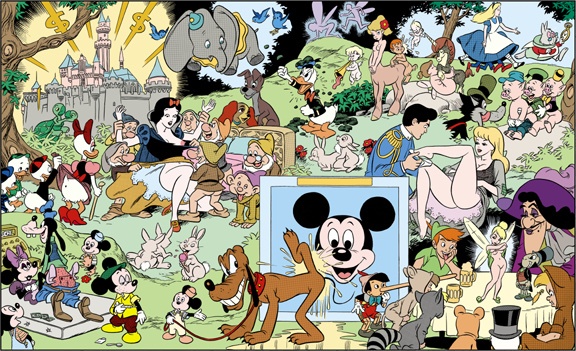Iconic Soviet filmmaker Sergei Eisenstein had a strong attraction with American cartoon animation and he in turn influenced their work. His cinematic technique of ”Juxtaposition” opened up non linear possibilities in the story-telling of the animated cartoon. He was a major influence on Hugh Harman as well as Walt Disney. Eisenstein,s approach to cinema was deeply theoretic, artistic and far too idiosyncratic for the commercial and formulaic conception to cinema used by Hollywood.
As Disney projected the capitalist utopia, Eisenstein represented a communist vision in pursuit of its own estcasy. They both understood that ideological representations in their films could shape the viewers conception of the world. Disney and others appropriated Eisenstein’s pioneering techniques of camera angles and especially ”montage’‘ , a specific use of film editing, ”that could be used to manipulate the emotions of the audience and create film metaphors”.
Eisenstein and other Soviet filmmakers of the avant-garde were fascinated by American ”eccentrism’‘ such as cops and robbers, cowboys and indians , jazz,gunfights and other American iconographisms characterized by speed, energy and exaggerated gestures and actions. Effectively, it was Chaplin who created this diversity of the medium in the silent age and cartoon animation was easily accomodated into the space opened up by pre-sound era Chaplin productions.
Eisenstein on Disney was published in 1986 and was a collection of various reflections on Disney by Eisenstein as well as the Russian’s perceptions of the Hollywood culture industries. The Eisenstein view of aestheics was concerned with the interplay and dynamic between the rational and sensuous in art. These ideas were mutually exclusive yet interacted to create a tension of unity when well executed.
Eisenstein felt the animated cartoon provided an idiom where Disney could implement the principle of ”totemism’‘ whereby man and animal are identical and the subjective and objective were indistinguishable from each other. Eisenstein saw the animated cartoon to be ”like a direct embodiment of the method of animism”. He equated animism with fire, an element characterized by its infinite changeability exemplified by Disney’s liberty to create infinite movement and form, both natural and unnatural within the animated medium. Eisenstein ultimately asserted the ancient connection between the flame and erotic ecstasy as being a dominant theme in Disney.
ption alignleft" style="width: 586px">

Wally Wood Realist Cartoon 1967








 COMMENTS
COMMENTS




This one is realy good for a cartoon freek like me!!!!!! Thumbs-up!
seemed to be the information I had. Perhaps Eisenstein had a contradictory nature or perhaps he loved/hated it at the same time. That article goes back a ways, and I can’t pinpoint the source exactly, though it seemed credible.